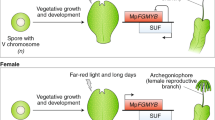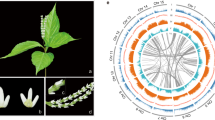Abstract
Recent advances in angiosperm phylogeny reconstruction1,2,3, palaeobotany4,5 and comparative organismic biology6,7,8 have provided the impetus for a major re-evaluation of the earliest phases of the diversification of flowering plants. We now know that within the first fifteen million years of angiosperm history, three major lineages of flowering plants—monocotyledons, eumagnoliids and eudicotyledons—were established5, and that within this window of time, tremendous variation in vegetative and floral characteristics evolved. Here I report on a novel type of embryo sac (angiosperm female gametophyte or haploid egg-producing structure) in Amborella trichopoda, the sole member of the most ancient extant angiosperm lineage. This is the first new pattern of embryo sac structure to be discovered among angiosperms in well over half a century. This discovery also supports the emerging view9,10,11,12 that the earliest phases of angiosperm evolution were characterized by an extensive degree of developmental experimentation and structural lability, and may provide evidence of a critical link to the gymnospermous ancestors of flowering plants.
This is a preview of subscription content, access via your institution
Access options
Subscribe to this journal
Receive 51 print issues and online access
$199.00 per year
only $3.90 per issue
Buy this article
- Purchase on Springer Link
- Instant access to full article PDF
Prices may be subject to local taxes which are calculated during checkout





Similar content being viewed by others
References
Soltis, P. S. & Soltis, D. E. The origin and diversification of angiosperms. Am. J. Bot. 91, 1614–1626 (2004)
Leebens-Mack, J. et al. Identifying the basal angiosperm node in chloroplast genome phylogenies: sampling one's way out of the Felsenstein zone. Mol. Biol. Evol. 22, 1948–1963 (2005)
Qiu, Y.-L. et al. Phylogenetic analyses of basal angiosperms based on nine plastid, mitochondrial, and nuclear genes. Int. J. Plant Sci. 166, 815–842 (2005)
Friis, E. M., Pedersen, K. R. & Crane, P. R. Fossil floral structures of a basal angiosperm with monocolpate, reticulate-acolumellate pollen from the Early Cretaceous of Portugal. Grana 39, 226–239 (2000)
Crane, P. R., Herendeen, P. & Friis, E. M. Fossils and plant phylogeny. Am. J. Bot. 91, 1683–1699 (2004)
Carlquist, S. & Schneider, E. L. The tracheid-vessel element transition in angiosperms involves multiple independent features: Cladistic consequences. Am. J. Bot. 89, 185–195 (2002)
Feild, T. S., Arens, N. C. & Dawson, T. E. The ancestral ecology of angiosperms: Emerging perspectives from extant basal lineages. Int. J. Plant Sci. 164, S129–S142 (2003)
Friedman, W. E. & Williams, J. H. Developmental evolution of the sexual process in ancient flowering plant lineages. Plant Cell 16, S119–S132 (2004)
Doyle, J. A. & Endress, P. K. Morphological phylogenetic analysis of basal angiosperms: Comparison and combination with molecular data. Int. J. Plant Sci. 161, S121–S153 (2000)
Endress, P. K. Origins of flower morphology. J. Exp. Zool. 291, 105–115 (2001)
De Craene, L. P. R., Soltis, P. S. & Soltis, D. E. Evolution of floral structures in basal angiosperms. Int. J. Plant Sci. 164, S329–S363 (2003)
Zanis, M. J., Soltis, P. S., Qiu, Y. L., Zimmer, E. & Soltis, D. E. Phylogenetic analyses and perianth evolution in basal angiosperms. Ann. Mo. Bot. Gard. 90, 129–150 (2003)
Stebbins, G. L. Flowering Plants: Evolution Above the Species Level (Harvard Univ. Press, Cambridge, 1974)
Cronquist, A. The Evolution and Classification of Flowering Plants 2nd edn (New York Bot. Gard., Bronx, 1988)
Porsch, O. Versuch einer phylogenetischen erklärung des embryosackes und der doppelten befruchtung der angiospermen (Gustav Fisher, Jena, 1907)
Schnarf, K. Vergleichende embryologie der angiospermen (Borntraeger, Berlin, 1931)
Johri, B. M. in Recent Advances in the Embryology of Angiosperms (ed. Maheshwari, P.) 69–103 (Int. Soc. Plant Morphol., Delhi, 1963)
Davis, G. L. Systematic Embryology of the Angiosperms (John Wiley and Sons, New York, 1966)
Donoghue, M. J. & Scheiner, S. M. in Ecology and Evolution of Plant Reproduction (ed. Wyatt, R.) 356–389 (Chapman & Hall, New York, 1992)
Mathews, S. & Donoghue, M. J. The root of angiosperm phylogeny inferred from duplicate phytochrome genes. Science 286, 947–950 (1999)
Parkinson, C. L., Adams, K. L. & Palmer, J. D. Multigene analyses identify the three earliest lineages of extant flowering plants. Curr. Biol. 9, 1485–1488 (1999)
Qiu, Y.-L. et al. The earliest angiosperms: evidence from mitochondrial, plastid and nuclear genomes. Nature 402, 404–407 (1999)
Soltis, P. S., Soltis, D. E. & Chase, M. W. Angiosperm phylogeny inferred from multiple genes as a research tool for comparative biology. Nature 402, 402–404 (1999)
Huang, B.-Q. & Russell, S. D. Female germ unit: Organization, isolation, and function. Int. Rev. Cytol. 140, 233–293 (1992)
Guo, F. L., Huang, B. Q., Han, Y. Z. & Zee, S. Y. Fertilization in maize indeterminate gametophyte1 mutant. Protoplasma 223, 111–120 (2004)
Tobe, H., Jaffre, T. & Raven, P. H. Embryology of Amborella (Amborellaceae): descriptions and polarity of character states. J. Plant Res. 113, 271–280 (2000)
Williams, J. H. & Friedman, W. E. Identification of diploid endosperm in an early angiosperm lineage. Nature 415, 522–526 (2002)
Friedman, W. E., Gallup, W. N. & Williams, J. H. Female gametophyte development in Kadsura: implications for Schisandraceae, Illiciales, and the early evolution of flowering plants. Int. J. Plant Sci. 164, S293–S305 (2003)
Williams, J. H. & Friedman, W. E. The four-celled female gametophyte of Illicium (Illiciaceae; Austrobaileyales): implications for understanding the origin and early evolution of monocots, eumagnoliids, and eudicots. Am. J. Bot. 91, 332–351 (2004)
Gifford, E. M. & Foster, A. S. Morphology and Evolution of Vascular Plants (W.H. Freeman and Co., New York, 1989)
Acknowledgements
I thank P. K. Diggle, R. H. Robichaux and L. Hufford for critical comments on the manuscript; K. C. Ryerson for assistance with all aspects of data collection and field work; and A. J. Redford, D. O'Connor, T. J. Lemieux and E. N. Madrid for assistance with various aspects of histology and field work. Field collections of Amborella in New Caledonia were made possible by permission of the Direction des Ressources Naturelles, Province Sud, Nouvelle-Calédonie and facilitated by B. Fogliani. This work was supported by grants from the National Science Foundation. To A.S.F., who read every paper I wrote.
Author information
Authors and Affiliations
Corresponding author
Ethics declarations
Competing interests
Reprints and permissions information is available at npg.nature.com/reprintsandpermissions. The author declares no competing financial interests.
Supplementary information
Supplementary Video 1
This movie shows several rotations of a three-dimensional computer reconstruction of the egg apparatus of the female gametophyte of Amborella. The three synergids cells are outlined in blue, green, and yellow and can be seen to abut the micropylar wall (shaded grey) of the female gametophyte. The egg cell is outlined in pink. When the synergids are removed from the computer image, the pyramidal shape of the egg cell is apparent, as well as the fact that the egg cell does not share a common cell wall with the wall delimiting the female gametophyte. (MOV 1424 kb)
Rights and permissions
About this article
Cite this article
Friedman, W. Embryological evidence for developmental lability during early angiosperm evolution. Nature 441, 337–340 (2006). https://doi.org/10.1038/nature04690
Received:
Accepted:
Issue Date:
DOI: https://doi.org/10.1038/nature04690
This article is cited by
-
Spontaneous emission of volatiles from the male flowers of the early-branching angiosperm Amborella trichopoda
Planta (2020)
-
Transcriptomics of manually isolated Amborella trichopoda egg apparatus cells
Plant Reproduction (2019)
-
Water lilies as emerging models for Darwin’s abominable mystery
Horticulture Research (2017)
-
Ovule ontogeny in Billbergia nutans in the evolutionary context of Bromeliaceae (Poales)
Plant Systematics and Evolution (2014)
-
Structural and developmental variability in the female gametophyte of Griffithella hookeriana, Polypleurum stylosum, and Zeylanidium lichenoides and its bearing on the occurrence of single fertilization in Podostemaceae
Plant Reproduction (2014)
Comments
By submitting a comment you agree to abide by our Terms and Community Guidelines. If you find something abusive or that does not comply with our terms or guidelines please flag it as inappropriate.



